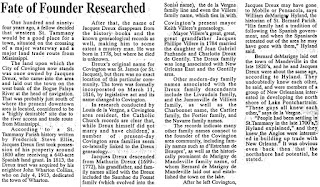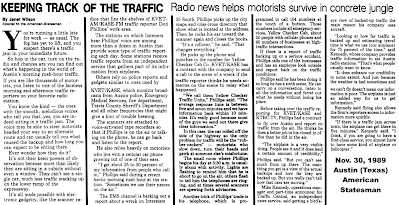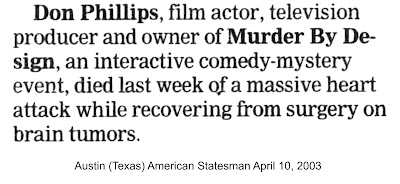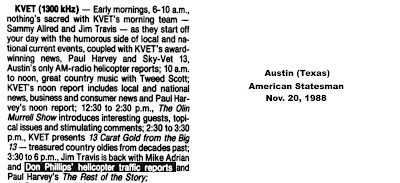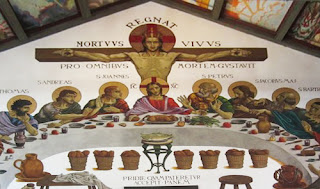Tuesday, May 31, 2016
Fate of Covington Founder Researched
According to the article, one hundred and ninety-four years ago, a fellow decided that western St. Tammany would be a good place for a town, situated on the crossing of a major waterway and a major land trade route from Mississippi.
The land upon which the City of Covington now stands was once owned by Jacques Dreux, who came into the area and laid out the town on the west bank of the Bogue Falaya River at the head of navigation. That was probably just south of where the present downtown area is located, considered to be a "highly desirable" site due to the river access and trade route from Mississippi.
According to a St. Tammany Parish history written by Frederick Steve Ellis, Jacques Dreux first took possession of his property around 1800 after receiving a 640-acre Spanish land grant. In 1813, the Dreux tract was acquired by his neighbor John Wharton Collins, who on July 4, 1913, dedicated the town of Wharton.
After that, the name of Jacques Dreux disappears from the history books and the known geneaological records as well, making him to some extent a mystery man. He was born in 1778, but where he died is unknown.
Dreux's original name for Covington was St. James (or St. Jacques), but there was no exact location of this particular community. The town was formally incorporated on March 11, 1816, by legislative act and its name changed to Covington.
In research conducted by Louis de la Vergne, a Covington area resident, the Catholic Church records are clear that, while Dreux himself did not marry and have children,4 a number of present-day Covington area families seem co-Iaterally linked to the Dreux geneaology.
Jacques Dreux descended from Mathurin Dreux (1699-1772), his grandfather, and family names allied with the Dreux included the Saunhac du Fossat familv (which evolved into the Soniat name), the de la Vergne family line and even the Villere family name, which ties in with Covington's present mayor Keith Villere's geneaology.
Mayor Villere's great, great, great grandfather Jacques Phillipe Villere in 1784 married the daughter of Jean Gabriel Fazhande and Charlotte Dreux de Gentily. The Dreux family was long associated with New Orleans East and the Gentilly area.
Other modern-day family names associated with the Dreux family descendants include the Livaudais family, and the Jumonville de Villiers family, as well as the Charbonnet name, the Cartier family, the Fortier family, and the Navarre family names.
The records indicate many other family names connect to the founder of the Covington area community, including family names such as d'Estrenan de Beaupre', as well as the historically prominent de Marigny de Mandeville family name, of whom Bernard de Marigny de Mandeville laid out and established the town on the lake.
After he left Covington, Jacques Dreux may have gone, to Mobile or Pensacola, says William deMarigny Hyland, the historian of St. Bernard Parish. "His family had a tradition of following the Spanish government, and when the Spaniards retreated out of the area he may have gone with them," Hyland said.
Bernard deMarigny laid out the town of Mandeville in the late 1820's, and he and Jacques Dreux were about the same age, according to Hyland. They undoubtedly knew each other, he said, and were members of a group of New Orleanians interested in developing the north shore of Lake Pontchartrain. "These guys all knew each other," says de la Vergne.
"People had been settling in St.Tammany in the late 1700's," Hyland explained," and they knew tthe Anglos were interested in building up trade with New Orleans. It was obvious even back then , that the northshore had potential, he stated.
Click on the image below to see a larger version of the article.
Johnny Bankston, County Agent
One of the most remarkable people I met when I first got into St. Tammany newspaper reporting was Johnny Bankston, county agent for the LSU Cooperative Extension Service. He was the guy who helped synchronize the farmers and ranchers and growers with the latest LSU research and recommendations. For the youth, there were the 4-H Club, Future Farmers of America (FFA) and a wide variety of farm animals and livestock organizations, all benefiting from the advice and guidance of the LSU Cooperative Extension.
The article below tells about Bankston's talk to the St.Tammany 4-H Horse Club, sharing with its members the benefits of owning and caring for horses and encouraging them towards rural lifestyles and self-sufficiency. Click on the image below to see the article in a larger version.
To view an article about the LSU Cooperative Extension and its staff in Covington in 1973, click on the image below.
Johnny Bankston died in 2004 and his obituary is at this link.
When Competing Fire Companies Used To Race To Fires
I was impressed by the concept of volunteers competing with each other to put out fires, so I wrote a song about it, and it was included among the songs selected for the St. Tammany Rivers music CD released in the early 1990's.
Here are three pictures of the fire companies getting ready for a parade. Click on the images to see a larger version.
Local Authors Night At The Library
Text from the above article:
Library Names Local Authors - April 19, 1984
The St Tammany Parish library system would like to honor both their readers and their local authors for National Library Week. St. Tammany Parish is very fortunate to have many talented authors who reside in our parish. The following is far from a complete list of the local authors and writers and some of their works. Many of them use the libraries for their research," a library spokesman said.
They include the following:
Victor Blackwell, Covington "O'er the Ramparts They Watched". 1976.
Colonel Wes Braud, Covington "A Family History" 1983
Jayge Carr, Slidell "Leviathan's Deep" 1979; "Navigator's Syndrome" 1983.
Mrs. Archie Core- Covington • "Tidbits about St Tammany Parish," 1954.
Frank Davis- Slidell "Fisherman's Guide to Lake Pontchartrain," "Frank Davis Seafood Notebook" 1983
Judge Frederick S. Ellis- Covington - edited "St Tammany Historical Society Gazette". Vol. 2.1977. "Other Side of the Lake: A History of Early Days in St Tammany Parish," 1961.
Carole Halston- Mandeville "Marriage Bonus," "Love Legacy," "Stand In Bride" Silhouette Romances
Lottie Harper- Pearl River "Miller's & United Families"
Doris Holden. Covington "On Through the Years With Abner Jenkins" 1970. "Cemetery Records" Vol 1 & 2 1977. "Saint Tammany Parish Marriage Records 1901 thru July 1924," 1980
Edith Koepp Hutchinson- Covington "Koepp Family Tree," 1980
Carol Jahncke- Covington "Louisiana Visit," 1976, "Mr Kentzel's Covington 1878-1890" 1979
John Kemp- "Martin Behrman of New Orleans' 1977," New Orleans 1981
Dr. Edwin 0. Jenkinson- Covington "Pocket Guide to Easy Office Opening"
Paul Marachal- Covington "Dancing Madly Backwards" working on book on loneliness and the journey into God
Mary Francis Morgan- Covington "Teacher Lady." 1952
Marty Mule. Slidell "Louisiana Athletes," 1981; "Sugar Bowl, the First Fifty Years," 1983
Bertha Perrand Neff- Covington "Index to the Marriages 1812 -1900" 1969. "Historical Tidbits and Statistics from the St Tammany Farmer 1878-1900"
C Howard Nichols "Louisiana's Florida Parishes: A Bibliography" , "St. Tammany Historical Society Gazette" Vol 3 1978; "Stories of a River Town - Covington, Louisiana at 200 Years,"2014
Ron Pedro- "Gathering Chase and Other Verse" 1976
Probably our most famous author is Walker Percy- Covington
"Last Gentleman" 1966.
"Love in the Rums " 1971
Lost m the Cosmos" 1983.
'Sovereign Wayfarer," "Message in the Bottle," 1975
"Moviegoer," 1961; "Lancelot," 1977 "The Second Coming" 1980 and "Lanterns on the Levee," 1941
Elois Sahuc- Abita Springs "Policeman Who Knew Huey P Long," 1977; "Slow Motion Suicide," 1981
Adrian Schwartz- Covington • "Sesquicentennial in St Tammany," 1963.
Sheila Stroup- Covington. Many articles published in Dixie Magazine of the Times Picayune newspaper
Leroy K. Willie - "Ancestors. Descendants and Related Families of John Willey and John Core" "Willey, Core Bennett and Other Ancestors". 1982
The St Tammany Parish library system would like to hear from many other local authors so that they could be added to this list
Here's a list: "Reveling," 1969; "Going Whacko and other Science Fiction Stories," 1977; "The Gafferty Perspective," 1994; "The Gafferty Momentum," 1997; "Cajun Gold," 2008; "The History of Sun," 2017; "The Southern Hotel-Covington Legacy," 2018, "The Pictorial Cartoon Maps," 2019, and "Posters from Imaginary Festivals and Conventions," 2019; "The Bridges of St. Tammany," "Abita Springs Photographs and Articles; "Folsom-Yesterday and Today," "Madisonville's Vantage Point Upon History;" "Madisonville Meanderings" 2023, "The Time When," 2022; "Going Knots," 2022, "The Morning Mist Mystery" 2023, "Mind Pivot" 2024, and "The Wedding Photographer" 2024.. He has published more than 50 cartoon pictorial maps showing bird's eye views of towns and cities, many of which may be viewed by CLICKING HERE.
St. Tammany's Part In The Revolutionary War
In August of 1971 Judge S. F. Ellis of Covington gave a speech entitled "Seven Flags Over St. Tammany Parish" for the Historical Preservation Society. It dealt with the events that took place around St. Tammany during the period of time of the American Revolutionary War (1775 to 1783). Here are some of the more interesting historical facts:
"After the Revolutionary War began, James Willing of Philadelphia, representing the colonies, came down the Mississippi River in an attempt to have the English settlers there join in the Revolution. Although he was cordially received, he met with little success. He later returned, with a small force of men, and attacked and burned the plantations, and otherwise terrrorized the settlers along the river.
"Among his other feats, he captured a British sloop, the Rebecca, and brought it to New Orleans, where he was cordially received by Bernardo de Galvez, the young Spanish governor.
"In 1779, Spain declared war on England, and Galvez captured the British forts at Manchac and Baton Rouge, the latter on September 21, 1779. In the meanwhile, the sloop Rebecca, re-named the Morris, was placed under the command of William Pickles, flying the colors of the United States.
"He entered Lake Pontchartrain and challenged the British sloop "West Florida," which, by virtue of being the only armed vessel in the lake, had dominated commerce thereon. Although outgunned and outnumbered, Pickles fired upon, boarded and captured the "West Florida." He then proceeded to the north shore of the lake, where he forced the British settlers to swear allegiance to the United States, and claimed the territory.
"This happened on the same day that Galvez captured Baton Rouge."
Judge Ellis had delivered this material because of its relevance to the upcoming Bicentennial Celebration in 1976. In fact, one of the events held during the Bicentennial Celebrations in St. Tammany was a re-enactment of that 1779 event where Captain Pickles came ashore at Mandeville lakefront and read the proclamation to the British settlers that they were now Americans.
A photo showing the boat landing at Mandeville during that re-enactment is below.
The 1779 encounter which took place near the mouth of Bayou St. John on the south shore, and Captain Pickles won the battle and took control of the lake. The ship was re-rigged and renamed Gálveztown. A few weeks later, he landed at Bayou Castine in Mandeville, gathered up the local residents and persuaded them to sign a “peace treaty” in favor of the American War of Independence.
Below is a picture of the "reading of the proclamation" during the 1976 re-enactment of the when the residents of the northshore surrendered to Captain Pickles.
Re-enactors reading the 1779 peace treaty in 1976, John Healy in suit on the left, and Miss Ella Paine at the right.
The treaty was signed by 19 people. A copy of it was sent to Philadelphia where, according to historian Don Sharp, it was read before the Continental Congress and was a source of encouragement to that group and helped build their resolve to keep up the good fight for Independence. Here is a newspaper article written about the incident.
Captain Pickles then did something that greatly affected the future of Mandeville. He patrolled Lake Pontchartrain, protecting the northshore as best he could from the ravages of war. He put the word out to all the pirates, criminals and opportunists in New Orleans to leave St. Tammany alone. It was a time of war, so there were groups of bad people going across the countryside, taking advantage of the situation, burning houses, stealing cattle and anything else of value they could get their hands on, even murdering families. They would use the cover of war to get away with doing things like that.
Capt. Pickles knew that many of those who lived on the northshore were American sympathizers, so he protected them. He let it be known that he vowed to catch and sink anyone trying to cross the lake to cause chaos on the north shore.
It was the kind of place that people just wanted to protect and preserve, people all the way from the earliest Native Americans to the most recent new residents.
According to an article in Wikipeda, following that successful expedition in south Louisiana, Pickles sailed on to Philadelphia, where the ship was sold.
"Pickles was then given command of Mercury, and charged with transporting Henry Laurens to the Dutch Republic on a diplomatic mission. The ship was captured off the coast of Newfoundland, and while Laurens were imprisoned in London, Pickles was imprisoned in Mill Prison in Plymouth. Pickles escaped from Mill on May 16, 1781, and eventually returned to Philadelphia."
According to Volume 13 of the Pennsylvania Colonial Records, he died in Philadelphia on September 9, 1783, after being assaulted by a gang of Italian sailors. The prosecution of his murderers was complicated by a legal question: whether statutes previously enacted by the British Parliament were still in force in the now independent state of Pennsylvania.Two of the sailors were sentenced on October 8, 1783, to hang ten days later.
Monday, May 30, 2016
The Phillips Family
Unfortunately, living in a travel trailer, stopping at a different campground each night, soon lost its luster and then, two months after they set out, they were involved in a serious accident on the highway. That sort of brought things to a standstill, literally and emotionally. They wound up in Austin, Texas, where they bought a house, started a vitamin shop in the college town, and did rather well in the health food business. They got healthier, wealthier, and happier in their new abode, putting their travel plans on hold indefinitely.
I went to visit them a few times, and was amazed to see the vitamin shop flourish with its version of the "smoothie," a relatively new idea at the time. I think they opened up a couple additional shops. It was a great adventure for Don and Jenny both, even though it wasn't the one they had planned on.
Thursday, May 26, 2016
100 Years Ago This Week (May 27, 2016)
Longtime Pilot Recalls Aviation Milestones
Elmer F. Bennett was a St.Tammany Parish resident in 1974, one of many airline pilots who lived in the area. In fact, St. Tammany was home to a large number of pilots in the late 1960's and early 1970's, many of them notable for their accomplishments. Here is an article about Bennett's contributions to the airline industry and his career recognitions.
I enjoyed interviewing him for the following article:
When it comes to seniority lists, whether in Congress or a passenger airline firm, being second from the top is certain to instill a sense of pride and accomplishment.
Covington area resident Elmer F. Bennett has experienced that pride, having served with Delta airlines for over 35 years. He has seen many innovations in the airline industry and has come through them all with flying colors. As a regular airline pilot, he is second in his field to put in 35 years of service.
And being second from the top of the seniority list is quite an honor, considering there's 3,205 pilots on this list.
He's been a resident of the Covington area for 20 years, with Bennett Lane at Old Landing named after him, in fact. He has had three children, Jay Jay, Gigi and Holly, all of whom went to Covington schools.
The fellow occupying the top spot on the seniority list was actually hired a year after he was, but he was hired by Delta, while Bennett was hired by the Chicago and Southern, a firm which later merged with Delta in 1953.
Bennett has four years of flying left before he retires as a regular line pilot at the age of sixty. He envies the chief pilots who can keep flying until they reach 65 years of age.
He was hired by Chicago and Southern Airlines of St. Louis in July of 1939, after his 21st birthday. He was the youngest airline pilot in the United States at the time, he said.
His first trip as a co-pilot was made the very next day. He's been at it ever since, except for 18 months with the Navy during World War II.
He drew some interesting comparisons about how things have changed since he began flying. "The airplane I started on in 1939 had two pilots, no stewardess, and seats for just ten passengers," Bennette recalled, "and the seats were seldom filled."
"The plane I presently fly seven times to San Francisco each month has three pilots, one passenger service supervisor, thirteen stewardesses and seats for 370 passengers, mostly filled."
The cost of the 1939 plane," he went on to say, "was in the neighborhood of $30,000. The cost of the one I now fly is some $30 million, and that's at the factory door in Seattle."
His flying speed has gone from 150 miles per hour in 1939 to 600 miles per hour today, he said, while his altitude has varied from 12,000 feet maximum to 45,000 feet maximum.
He recalled his starting salary back then to be $190, but classified his present salary as a "military secret."
Bennett was recently recognized by the Delta Newsletter which congratulated him on his 35 years of the job and thanked him for a job well done.
Newspaper article printed in the St. Tammany Farmer on August 15, 1974
Wednesday, May 25, 2016
St. Joseph Abbey Houses Art Treasures
St. Joseph Abbey Houses Art Treasures
One wouldn't expect to find the world's largest mural of The Last Supper at a monastery in a tiny southeast Louisiana town. But, expect it or not, that's just what the small community of Benedictine monks believe they have.
Painted by Benedictine artist Gregory deWit in 1946, the mural covers the entire west wall of the Refectory (dining room) of the Abbey St. Joseph located about 35 miles north of New Orleans.
Measuring 98 by 21 feet, the mural is full of bright, pure, and rich colors and is the focal point of all the other wall and ceiling paintings. Figures in all the paintings face toward The Last Supper, symbolically indicating Christ as the center of Creation and all that Creation shares in the preparation of the material elements essential to the sacrifices of the Eucharist.
Above it, the Latin inscription proclaims that "Christ, though slain, yet lives and reigns."
Father Gregory's talent continues in evidence in the wall panels depicting Adams and Eve, Abraham, Joseph, Elias, Moses, Manna from Heaven, the Paschal Supper, and the Good Shepherd. On the ceiling of the Refectory are 56 panels on which the artist depicts fire, air, water, and Earth with the signs of the Zodiac, Chinese pheasants, various fishes and animals.
As one leaves the Refectory, a large painting of Saint Benedict dominates one's view. In one hand, he holds a staff indicating the office of Abbot and in the other hand the Rule, the code of life for Benedictine monks.
Father Gregory worked on the murals between 1946 and 1950. The monastery was founded in 1889 at Gessen, La., about 20 miles southwest of its present location. It moved to its current 1200 acre site north of Covington, La., in 1901. By 1906, the monastery has five buildings, a prospering school and thriving crops.
The following year, a fire destroyed all of the wooden structures, along with the books and personal effects of the monks. Determined to stay, work began on new buildings, this time in brick. One of the first buildings constructed was the Refectory. It and the Abbey church, constructed in 1932, are parts of the Abbey best known to the public because of their magnificent religious art.
Father Gregory's work shows great character in the personages he painted and there is enormous detail in his work, especially in the elaborate folding of cloth in the robes. Milo's work is more simple and direct.
In the high point of the half dome is the figure of Christ, symbolically bringing life to the world. He is rising on the wings of Cherubim. Beneath this, the artist has land and water with angels underneath holding up Creation.
The angels are separated by niches; their wings folded over each niche in the lower dome so as to encapsulate evil. Depicted within each niche is one of the capital sins. Satan is in the center niche directly below Christ. The satanic depictions are in very dark colors almost undetected at first sight.
At the base of the half dome are stained glass windows showing the figures of Melchizedek, King David, Isaiah and Daniel from the Old Testament to John The Baptist, who was a precursor to the New Testament.
A smaller full dome resting on four massive arches precedes the half dome and is directly above the altar. It is adorned with floating angels. Shown on the walls are the Virgin Mary's marriage to Joseph, the Annunciation, the Nativity, and the Feast at Cana. The Christological series follows, though somewhat overlapping, with His coming being announced, His birth, crucifixion, resurrection, and ascension.
Then begins the cycle of the Holy Spirit who comes at Pentecost, and the Virgin Mary ascending into Heaven. St. Benedict, the founder of the Order, and his sister, Saint Scholastica, and other saints are depicted.
The remaining walls contain paintings, all with Latin inscriptions, explaining the person or event. A large mural over the entrance to the church depicts the Final Judgment with the faithful from all walks of life.
Father Gregory, an outstanding and creative artist, had a sense of humor that came out in his works. For example, he put two altar boys dressed in the 1950 style altar robes in the portrayal of the marriage of Mary and Joseph. Showing an event taking place in Palestine, he placed a bunch of magnolias, a flower popular in the area and the rest of the South. In the Final Judgment mural, the artist portrayed himself.
The 60 monks of St. Joseph generously share their art with the outside world and lend their talents to the community. They have three apostolates: St. Joseph Seminary College, a four year liberal arts college for men preparing for the priesthood; the Christian Life Center, a retreat house; and the Abbey Youth Camp, a summer program operated with the Knights of Columbus.
Visitors may tour the grounds and view the art in the church during daylight hours. The Abbey is located in St. Benedict, La., off La. Hwy. 25 about four and a half miles north of Covington.
Brief Chronology of St. Tammany Parish History
Tuesday, May 24, 2016
Fair Association Leaders
When I first became involved in the group, it was 1972. Here is a list of the names of those individuals who were leading the association at that time.

